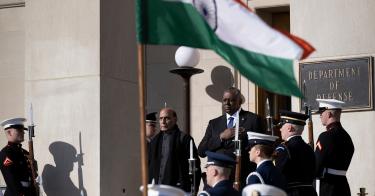Secretary of State Antony Blinken and Defense Secretary Lloyd Austin in April hosted their Indian counterparts, External Affairs Minister S. Jaishankar and Defense Minister Rajnath Singh. The ministers met for the fourth edition of the 2+2 defense and foreign policy dialogue that began during the Trump administration.
The talks were preceded by a virtual meeting between President Joe Biden and Prime Minister Narendra Modi as the two countries celebrated 75 years of diplomatic relations. The dialogue was largely successful, if not entirely groundbreaking. What was achieved may have been less important than what was avoided: a diplomatic rupture over the Russia-Ukraine crisis.
At the 2+2, both sides offered lofty rhetoric about the health and future of India-U.S. ties. “There’s virtually no domain on which we are not cooperating with each other,” Jaishankar declared. Austin called the relationship the “cornerstone of security in the Indo-Pacific.” Singh signaled India’s happiness with the numerous “foundational” military agreements signed in recent years, insisting the two sides would “double up capabilities across conventional and emerging defense domains.” Readouts of the discussions noted the two militaries are operating “closely together across all domains” and would “jointly meet the challenges of this century.”
Perhaps the most interesting takeaway from the meeting was a proposal to “explore possibilities of utilizing Indian shipyards for repair and maintenance of ships of the U.S. Maritime Sealift Command to support mid-voyage repair of U.S. Naval Ships.” Beyond that, the dialogue produced a handful of modest but positive developments. These included an agreement to cooperate on space situational awareness as well as the launching of a new Defense Artificial Intelligence Dialogue. They also involved commitments to joint service engagements to support high-end combined operations; to the co-production of air-launched unmanned aerial vehicles; and to expanded joint cyber training and exercises.
>>> Don’t Let Putin’s War in Ukraine Damage U.S.-India Ties
India also announced that it would join Combined Maritime Forces Bahrain, a “multinational maritime partnership, which exists to uphold the Rules-Based International Order by countering illicit non-state actors on the high seas and promoting security, stability, and prosperity.”
Arguably the most important outcome was the two sides’ ability to navigate differences over Russia and the Ukraine crisis. India and the U.S. have never seen eye-to-eye on Russia, but Putin’s invasion has brought their quiet disagreements to the forefront.
Some U.S. commentators cried foul when India voted repeatedly to abstain from criticizing Russia at the United Nations for its conduct in Ukraine. They called into question India’s credentials as a democratic member of the Quad while it continued to import Russian oil and gas.
The U.S. government, however, has adopted a more flexible approach. It recognizes that most of India’s legacy military hardware is of Russian origin. The Indian government believes it can ill afford to alienate its top defense supplier while its border dispute with China grows more violent and volatile. The U.S. government also recognizes that, in the subtle language of diplomacy, India’s position has shifted from stoic neutrality to criticism of Russia’s actions —- without naming Moscow explicitly.
In a break from its early statements on the crisis, the Indian government is now denouncing violations of international law, sovereignty, and territorial integrity in Ukraine. New Delhi has also condemned the horrific killing of civilians in Bucha and, unusually for India, called for an international inquiry into the atrocity. “All these statements, without naming [Russia], are clearly aimed at indicating unhappiness towards what Russia has done,” explained former Indian Permanent Representative to the United Nations Syed Akbaruddin. Modi has also spoken to Ukrainian President Volodymyr Zelenskyy twice. Modi is rumored to have signaled India’s opposition to the war in direct conversations with Russian President Vladimir Putin.
The Bucha killings in particular may have marked a turning point in Indian public opinion. With several Indian reporters in Ukraine broadcasting images of the horrors back home, the Indian press has engaged in unusually lively criticism of Russia’s actions in Ukraine. Some have questioned Moscow’s ability to remain a reliable supplier, with Russia’s own military industrial base being drained by the Ukraine conflict. Others are increasingly unnerved by Russia’s deepening embrace of China and Moscow’s neutrality during recent flare-ups at the China-India border.
Arguably the only time Russia has notched a victory in Indian public opinion is when the U.S. government has been perceived as threatening or lecturing India over Ukraine. A trip to New Delhi by Deputy National Security Advisor Daleep Singh earlier this month ruffled feathers when he was quoted threatening “consequences” for any Indian attempts to evade U.S. sanctions while importing Russian energy.
>>> The Indo-Pacific Strategy Needs Indo-Specifics
This month, the White House sought to clear the air. When asked if, during a pre-meeting phone call, Biden had pressured Modi to reduce Russian oil imports, a White House spokeswoman noted Russian energy represents only 1%-2% of total Indian energy imports, adding: “They’re not violating any sanctions by importing oil. It’s a decision we made to stop importing oil. Different countries have their own calculation.”
Meanwhile, on the defense relationship with Russia, Blinken explained that India developed those ties “at a time when the U.S. was not able to be a partner to India. Times have changed. Today we are able and willing to be a partner of choice with India across virtually every realm.”
In the spectrum of U.S. interests at stake with India, the Indo-Pacific, the Quad, and the China challenge outrank the country’s legacy ties with Russia. There is little merit to creating a rift with New Delhi over a war India opposes and whose outcome it is unable to affect. Rather than sanctioning India for its legacy reliance on Russian military hardware, it is better for the U.S. to show that it is a more reliable and superior alternative as India continues the important but sluggardly process of weaning itself off Russian arms. The April 2+2 was a step forward in the right direction.
This piece originally appeared in RealClear World




